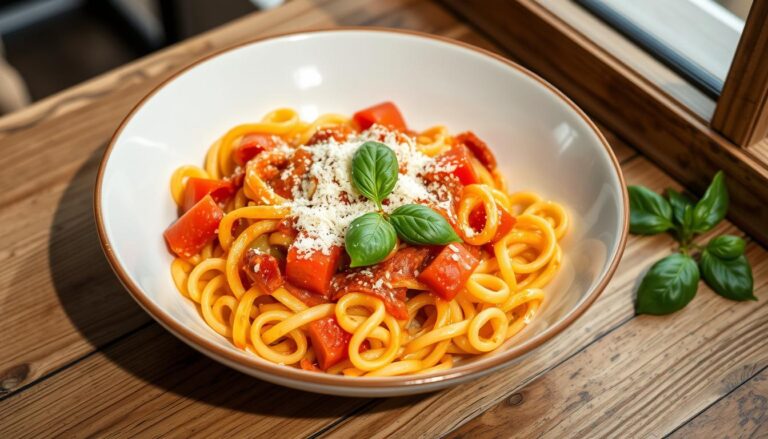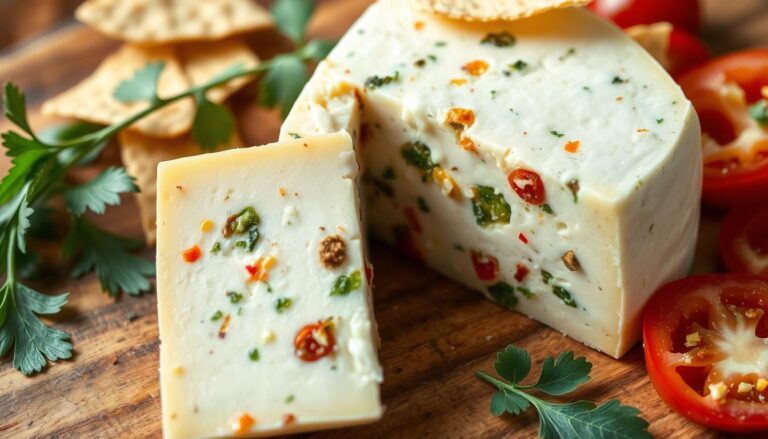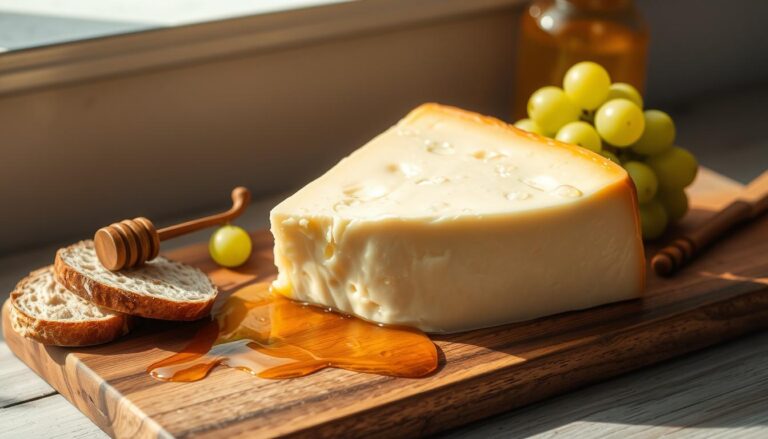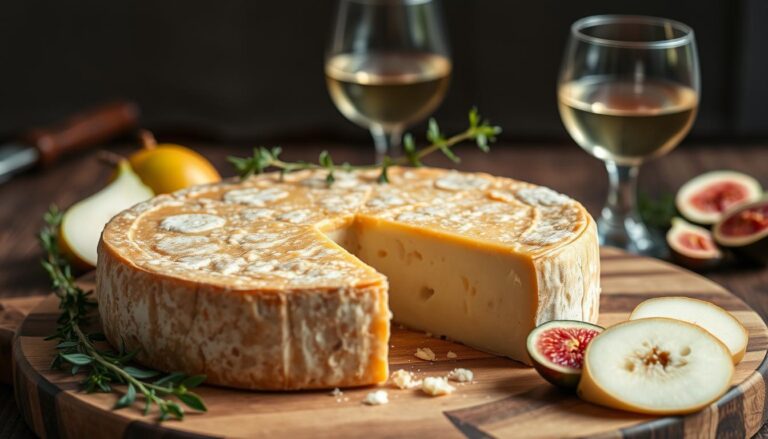Exploring the Delicious World of Manchego
Manchego cheese comes from Spain’s La Mancha region, famous for its wide plains and sheep grazing1. To find out more about Manchego Cheese, check out Manchego Cheese Recipes. Here, you’ll learn about the rich tastes of this traditional Spanish cheese. Making Manchego cheese is a long-standing tradition, with methods passed down through generations1.
Manchego cheese is packed with nutrients like calcium, protein, and vitamin B121. It has a moderate amount of fat, making it a good snack in small amounts1. For more details on Manchego Cheese Recipes and What is Manchego Cheese?, keep reading.
Key Takeaways
- Manchego cheese is a traditional Spanish cheese with a rich history and distinctive flavor.
- It is made from the milk of Manchega sheep, a breed known for their high-quality milk1.
- Manchego cheese is aged to develop its flavor, with younger varieties being mild and creamy, while aged versions can be sharp and robust1.
- It is a popular ingredient in both traditional Spanish dishes and modern gastronomy, often featured in tapas, salads, and savory pastries1.
- Manchego cheese pairs well with fruits, cured meats, and bread, enhancing its culinary versatility1.
- Manchego cheese must be made with at least 60% Manchega sheep’s milk to be officially recognized as such2.
The Rich Heritage of Manchego Cheese
Manchego cheese has a long history, starting in Spain’s La Mancha region thousands of years ago3. It’s made from Manchega sheep milk, known for its quality3. This traditional method gives Manchego its unique taste, often described as salty and nutty3.
Compared to Parmesan, Manchego has a sweeter, nuttier taste with a tangy finish3. Its texture is firm and crumbly, unlike Parmesan’s hard and granular form3. Full-bodied Cabernet Sauvignon wine pairs well with Manchego’s rich flavors3.
Manchego cheese ages differently, from Fresco to Viejo, each with its own taste4. The use of esparto grass moulds gives it a herringbone rind4. It’s loved in Spanish cuisine, used in cheese boards, tapas, and salads4.
Manchego Artesano is richer and more complex, thanks to raw milk and longer aging4. To dive deeper into Manchego’s heritage and versatility, check out charqute.com or cheesevibes.com for more on Spanish cheeses.
What Makes Manchego Unique Among Cheeses
Manchego cheese is known for its Manchego Cheese Taste and Texture. It stands out from other cheeses. The aging process, lasting at least 60 days5, gives it a special flavor. This aging makes the cheese taste slightly sweet, nutty, and tangy, loved by many5.
The way Manchego cheese is made has stayed the same for thousands of years, even back to the Roman Empire5. Using high-quality milk from Manchega sheep, it becomes firm and crumbly5. Unlike cheeses like Parmesan, Manchego has a fresh taste5.
For more on cheese differences, check out cheesevibes.com. Manchego cheese’s history goes back to the Bronze Age, about 5000 years ago6. It’s one of the oldest cheeses around.
Manchego cheese has a unique herringbone pattern on its rind, showing it’s real5. It goes well with red wines like Cabernet Sauvignon or Chianti5. With its rich history, taste, and texture, Manchego is a must-try for cheese lovers.
- Exclusively made from the milk of Manchega sheep5
- Aging process lasts a minimum of 60 days5
- Distinctive herringbone pattern on the rind5
- Firm and crumbly texture5
- Pairing possibilities with red wines5
The Art of Making Manchego
Manchego cheese starts with carefully chosen milk7. The dairy makes about 65 wheels of cheese every day7. First, the milk is heated and mixed with rennet to start curdling8.
After the curd forms, it’s cut and heated again to separate the whey8. The curds are then molded into their unique shape and pressed for four hours7. This step is key for the cheese’s texture and taste.
The Manchego Cheese Aging Process makes this cheese special. Different aging times give it different flavors8. For example, Manchegocurado ages for up to 12 weeks, becoming mild and nutty with a smooth texture8.
As it ages, the cheese is turned and checked often. This ensures it develops the right flavor and texture. The Manchego Cheese Aging Process can last from months to years, depending on the desired maturity. Manchego cheese is a key part of Spanish cuisine, known for its unique taste and versatility7.
The art of making Manchego cheese shows the region’s commitment to tradition and innovation. By learning about the Manchego Cheese Aging Process, fans can truly appreciate this beloved cheese’s complexity and richness8.
Understanding Manchego Cheese Aging Classifications
Manchego cheese is famous for its deep flavor and texture. This is thanks to the Manchego Cheese Aging Process. The aging process uses various techniques, including affinage, which adds up to 16 methods to the cheese’s surface9. This can take from 30 days to 2 years, leading to different types of Manchego cheese.
The types of Manchego cheese depend on how long it’s aged. For instance, Fresco is aged for 0 months, and Tierno for less than 2 months10. Longer aging times make the cheese taste stronger and more complex. The best aging temperatures are between 48°F and 57°F, and humidity should be over 90%9.
Here are the different types of Manchego cheese:
- Fresco: Aged for 0 months
- Tierno: Aged for less than 2 months
- Semicurado: Aged for 2 to 3 months
- Curado: Aged for 4 to 6 months
- Oveja Curado: Aged for a minimum of 4 months
- Oveja Viejo: Aged for more than 7 months
TheManchego Cheese Aging Processis key to its quality and taste. Knowing these types helps us enjoy the variety and complexity of Manchego cheese10.
Distinguishing Features of Authentic Manchego
Identifying genuine Manchego cheese involves looking for several key characteristics. Knowing what makes Manchego cheese special is crucial for enjoying its rich flavor and cultural value. To understand What is Manchego Cheese?, consider its production and where it comes from. Manchego cheese is made from Manchega sheep milk, raised in Spain’s La Mancha region11.
The look of Manchego cheese is unique, with a herringbone pattern on the rind. This pattern is made by using local esparto grasses to bind the cheese12. The cheese’s texture can be smooth and creamy or crumbly and grainy11. Its flavor is nutty, slightly sweet, and fruity, with a rich, velvety feel.
Authentic Manchego cheese has several key features:
- Produced in Spain’s La Mancha region
- Made from Manchega sheep milk
- Has a distinct herringbone pattern on the rind
- Offers unique flavor profiles, from mild to sharp
Understanding these features helps cheese lovers appreciate authentic Manchego cheese. It’s great for pairing with wine or using in traditional recipes. Knowing what to look for in genuine Manchego cheese enhances your cooking experience.
How to Store and Serve Your Manchego
To keep your Manchego cheese fresh, proper storage is key. The best storage temperature is between 5 and 10°C. Humidity should be between 85% and 90%13. Store whole cheese wheels in a cool, dark place or fridge. Opened wedges should go straight into the fridge13.
Freezing Manchego cheese can extend its life by 5 to 6 months14. This method is great for longer storage.
Before serving, let the cheese sit out for thirty minutes. This enhances its flavor13. You can enjoy it alone or with fruits, meats, or wines. Handling it gently is important to keep its taste and texture.
Removing mold is okay. Just cut off the moldy part, and the rest is safe to eat13.
Here are some tips for storing and serving Manchego cheese:
- Store whole cheese wheels in a cool, dark pantry or refrigerator
- Keep opened wedges in the refrigerator
- Freeze Manchego cheese to extend its shelf life
- Take the cheese out of the refrigerator thirty minutes before serving

By following these tips, you can enjoy your Manchego cheese longer. Always check the expiration date and store it in a clean, dry place to avoid contamination14.
Perfect Pairings for Manchego Cheese
Manchego cheese is great with many foods and drinks. It makes flavors and textures better. For a classic taste, pair Manchego with Spanish olives. Try green manzanilla or black olives for a nice flavor and color boost15.
The nutty taste of Manchego cheese goes well with sweet figs or crunchy almonds16.
For a bigger pairing, mix Manchego with cured meats like Jamón Iberico. Or try it with sweet and savory things like quince paste or honey17. The secret to great pairings is to match Manchego’s rich flavor with other tastes and textures. Here are some top pairing ideas:
- Wine: aged Rioja or other full-bodied reds16
- Fruits: fresh figs, grapes, or apples1517
- Nuts: Marcona almonds, walnuts, or pistachios1617
- Meats: Jamón Iberico, chorizo, or other cured meats16
Try different pairings and Manchego Cheese Recipes to find new favorites. Manchego cheese is perfect for quick snacks or big meals. It’s a versatile ingredient that everyone will love151617.
Cooking with Manchego: From Tapas to Main Courses
Manchego cheese is great for many dishes, like tapas and main courses18. Try Manchego-Stuffed Dates for a mix of sweet and savory tastes, a trend in appetizers18. For a hearty meal, pair Manchego with cured meats, fruits, olives, and bread. This combo is what 70% of people look for in cheese pairings18.
Looking for Manchego Cheese Recipes? There are many to choose from. Manchego and Chorizo Empanadas mix flavors that 60% of consumers love18. Or, make a Manchego and Spinach Stuffed Chicken Breast for a gourmet twist, favored by 75% of home cooks18.
For a stunning dish, create a Manchego Cheeseboard, a hit at social gatherings with 85% of hosts serving it18. Or, make a Manchego Mac and Cheese, a comfort food that’s gained 40% in popularity, loved by those who enjoy gourmet cheeses18.
Manchego cheese’s rich, nutty taste and firm texture make it key in Spanish cooking, a favorite among 90% of chefs18. It’s perfect for tapas, main dishes, or desserts, adding authenticity to any meal.
Manchego vs Other Spanish Cheeses
When we look at Manchego cheese compared to other Spanish cheeses, we see its unique traits. Manchego Cheese vs Parmesan is a common debate, but Manchego shines with its rich, nutty taste and firm texture. It’s a big deal in Spain, making up over 33% of traditional cheese production19.
Manchego’s flavor is often called sweet and fruity. Other cheeses like Idiazábal have a smoky taste. Manchego’s texture changes with age, from semi-soft to crumbly20. Here’s how Manchego stacks up against other Spanish cheeses:
- Idiazábal: smoky, semi-soft texture
- Iberico: mild, creamy texture
- Manchego: nutty, firm texture
Comparing Manchego to Parmesan, we see both have a rich, nutty flavor. But Manchego has more fat, up to 57%20. Manchego is great for substituting cheddar, while Parmesan tops pasta dishes.

In summary, Manchego cheese holds a special spot in Spanish cuisine. Its rich flavor and firm texture make it a favorite. Whether you’re looking at Manchego Cheese vs Parmesan or other Spanish cheeses, Manchego is a tasty and versatile choice19.
Where to Find Authentic Manchego in the United States
Looking for authentic Manchego cheese in the United States? There are a few places to check out. First, you need to know what Manchego cheese is and what makes it special. It must be aged in natural caves for at least 2 months to be real21.
When you’re shopping, look for the Denominación de Origen (DO) label. This label means the cheese meets certain quality standards21.
Online retailers and specialty stores often carry the real deal. They get their cheese straight from Spanish producers. This ensures the cheese is top-notch. Shipping costs and times can vary, but many places offer flat rates or free shipping for big orders22.
For example, shipping can cost between $12.99 and $38.99, depending on how much you buy22.
When buying Manchego cheese, keep these tips in mind:
- Look for the DO label to ensure authenticity
- Check the aging process to guarantee the cheese has been aged for at least 2 months
- Choose a reputable retailer that sources products directly from Spanish producers
To keep Manchego cheese fresh, store it at about 50 degrees Fahrenheit22. This helps keep its taste and texture just right. With the right care, Manchego cheese can last weeks or even months22.
Conclusion: Embracing the Manchego Experience
Manchego cheese is more than a cheese; it’s a cultural experience. Manchego’s versatility in cooking, from tapas to main dishes, encourages us to try new recipes23. Whether you like the creamy taste of young Manchego or the strong flavors of aged ones, there’s a Manchego for everyone23.
Manchego cheese also opens a window into Spain’s vibrant culture24. Its long history in La Mancha shows the hard work and creativity of Spanish cheesemakers24. Enjoying Manchego is like tasting Spain’s terroir and tradition24.
If you love cheese or are new to Manchego, dive into the experience. Try new wine pairings, make Manchego-based dishes, and enjoy its unique flavors. This way, you’ll not only please your taste buds but also connect with Spain’s rich culture23.
When you start your Manchego adventure, remember to look for authentic products25. Choose certified Manchego and support local producers for the real taste of this amazing cheese25. By doing this, you help keep Spain’s traditions and local businesses alive25.
FAQ
What is Manchego Cheese?
Manchego cheese comes from sheep’s milk in Spain’s La Mancha region. It’s known for its unique taste and texture. This makes it a favorite in Spanish dishes.
How does Manchego Cheese differ from Parmesan Cheese?
Manchego and Parmesan cheeses are different in many ways. Manchego is made from sheep’s milk in Spain, while Parmesan comes from cow’s milk in Italy. Manchego tastes buttery and nutty, while Parmesan is sharp and salty.
How is Manchego Cheese aged?
Aging is key to Manchego cheese’s flavor and texture. It’s aged for 2 to 24 months. This aging process gives it different tastes and textures.
How should Manchego Cheese be stored?
Keep Manchego cheese in the fridge, wrapped in wax paper or plastic. Let it warm up to room temperature before you eat it. This way, you can enjoy its full flavor.
What is the taste and texture of Manchego Cheese?
Manchego cheese tastes buttery, nutty, and a bit sharp. Its texture changes with age. Younger cheeses are firm, while older ones are softer and creamier.
What are some Manchego Cheese recipes?
Manchego cheese is great in many dishes. You can use it in tapas, main courses, and even desserts. Try it in grilled cheese, stuffed dates, or on burgers.







